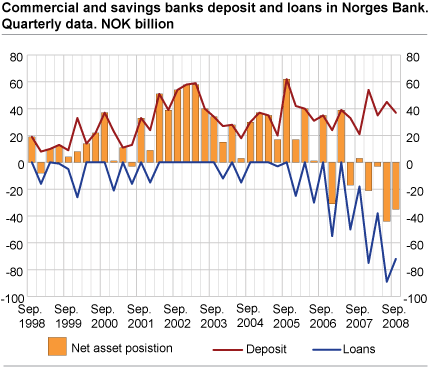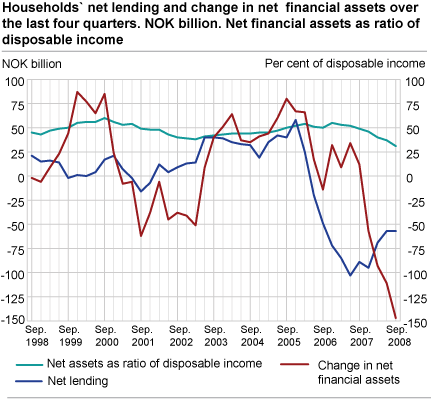Content
Published:
This is an archived release.
Huge holding losses on securities
Net lending in the third quarter of 2008 was to a small extent influenced by the financial crisis, but the fall in market prices on securities has led to holding losses for the institutional sectors.
The securities' holdings by the end of the third quarter of 2008 were strongly affected by the financial instability. Among the sectors with the largest holding loss are households and non-profit institutions. Households' holding losses amounted to NOK 90 billion in the last four quarter period, of which half of the loss was due to the quoted development in the third quarter of 2008.
Households' net financial assets ratio fell significantly in the third quarter
Households' net lending is calculated as NOK -57 billion in the four quarter period including the third quarter of 2008, which is at the same level as the previous four quarter period. However, financial investments as well as borrowing fell substantially in the last quarter. Households' net financial assets were reduced by NOK 147 billion in the last four quarter period. Most of the reduction took place in the third quarter, when net financial assets fell by almost NOK 70 billion. Households' net financial assets were estimated at NOK 301 billion at the end of the last quarter. This constitutes 31.3 per cent of disposable income, while net financial asset ratio was 37.3 per cent at the end of the second quarter of 2008.
Banks loans exceed deposits in the Central Bank
In the last four quarters, commercial and savings banks' loans have exceeded deposits in the Central Bank of Norway. Domestic banks normally have higher deposits than loans in the Central Bank, but due to the financial instability the Central Bank increased loans to banks to strengthen their liquidity. By the end of the third quarter of 2008, commercial and savings banks' loans in the Central Bank amounted to NOK 72 billion. At the same time, the deposits amounted to NOK 37.5 billion, which placed the banks in a net borrowing position of NOK 34.5 billion to the Central Bank of Norway.
Highest recorded level of net lending in central government
Holding losses on securities reduced central government's net financial assets by more than NOK 64 billion in the third quarter of 2008. The modest decline in net financial assets is due to the record level of net lending in a quarter and holding losses on foreign assets being moderated due to the weakened Norwegian krone at the end of the quarter. Net lending was NOK 166 billion in the last quarter, which is up NOK 42 billion from the second quarter of 2008.
The central government's net financial investments abroad amounted to almost NOK 102 billion in the third quarter of 2008, which to a large extent led to a high level of net lending to the rest of the world. In the last quarter, Norway's net lending to the rest of the world was NOK 116 billion, which is a modest decline of NOK 7 billion from the second quarter of 2008.
Net financial assets abroad increased in the third quarter
Norway's net financial assets abroad were calculated at NOK 1 412 billion in the last quarter. This is up NOK 177 billion from the previous quarter, when net financial assets abroad were calculated at NOK 1 235 billion. In addition to high net lending, the fall in stock market prices on Oslo Stock Exchange and currency exchange rate developments increased net financial assets abroad. Foreign shareholders sold off quoted shares in the third quarter of 2008.
| 3. quarter 2006 | 4. quarter 2006 | 1. quarter 2007 | 2. quarter 2007 | 3. quarter 2007 | 4. quarter 2007 | 1. quarter 2008 | 2. quarter 2008 | 3. quarter 2008 | |||||||||||||||||||||||||||||||
|---|---|---|---|---|---|---|---|---|---|---|---|---|---|---|---|---|---|---|---|---|---|---|---|---|---|---|---|---|---|---|---|---|---|---|---|---|---|---|---|
| Financial assets | 4 781 | 4 976 | 5 279 | 5 367 | 5 369 | 5 532 | 5 375 | 5 481 | 5 797 | ||||||||||||||||||||||||||||||
| Liabillities | 3 439 | 3 701 | 3 994 | 4 072 | 4 115 | 4 277 | 4 113 | 4 246 | 4 385 | ||||||||||||||||||||||||||||||
| Net financial assets/net financial wealth | 1 342 | 1 275 | 1 284 | 1 295 | 1 253 | 1 254 | 1 262 | 1 235 | 1 412 | ||||||||||||||||||||||||||||||
| Change in net financial assets/net financial wealth | 208 | -66 | 9 | 11 | -42 | 1 | 8 | -27 | 177 | ||||||||||||||||||||||||||||||
| Other changes | 109 | -168 | -73 | -56 | -136 | -116 | -93 | -150 | 61 | ||||||||||||||||||||||||||||||
| Net lending | 99 | 101 | 82 | 67 | 95 | 117 | 101 | 123 | 116 | ||||||||||||||||||||||||||||||
DefinitionsNet lending as defined in non-financial accounts (capital account) = savings + net capital transfers - net acquisition of non-financial assets Net lending as defined in financial accounts = net acquisition of financial assets - net incurrence of liabilities Savings is non-consumed income and can be invested in financial or non-financial assets. If savings exceed non-financial investments, a sector has a surplus of funds and becomes a net lender to other sectors. In the financial transaction account, this means that the sector acquires more financial assets than liabilities. On the other hand, if savings are less than non-financial investments, investments have to be funded either by selling financial assets or incurring debts. Household investments in non-financial assets mainly reflect the purchase of new housing and fixed investments by unincorporated enterprises. They typically finance substantial parts of these investments by incurring debt in the form of loans. Net financial assets (net financial wealth) = total financial assets - total liabilities The financial balance sheet shows the financial position of a sector at the end of the reference period and is broken down into the categories of financial assets and liabilities. Insurance technical reserves, currency and deposits are the predominant assets held by households, while loans provided by financial corporations (banks etc.) constitute the main proportion of liabilities. Changes in net financial assets = net lending + other changes in assets, net The change in the financial balance sheet during the reference period is a result of accumulated financial transactions and other changes in assets. The latter category mainly reflects revaluations due to changes in market prices of financial instruments. |
Contact
-
Torbjørn Cock Rønning
E-mail: torbjorn.cock.ronning@ssb.no
tel.: (+47) 97 75 28 57
-
Jon Ivar Røstadsand
E-mail: jon-ivar.rostadsand@ssb.no
tel.: (+47) 21 09 43 69
-
Marit Eline Sand
E-mail: marit.sand@ssb.no
tel.: (+47) 40 90 26 74


